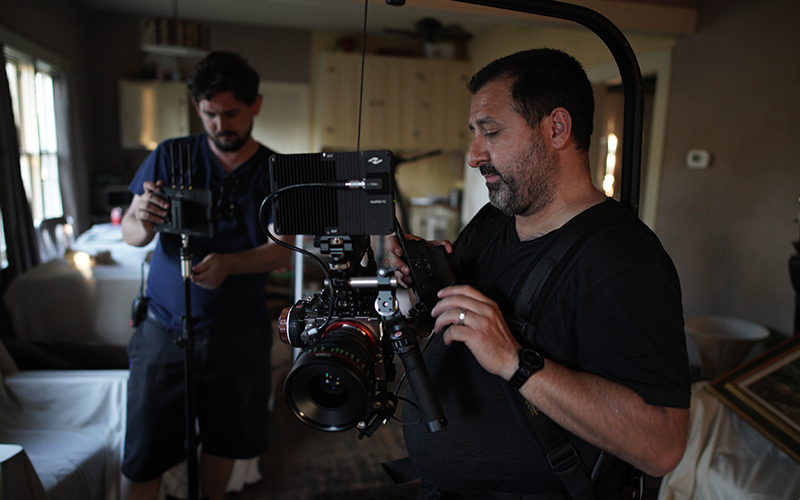PHOENIX – Anita Verma-Lallian launched Camelback Productions, which she says is Arizona’s first woman- and South Asian-owned film production and entertainment company, in January following the passage of the state’s film tax credit.
Verma-Lallian said she had been interested in starting a production company, and the film tax credit, which incentivizes production companies to shoot primarily in Arizona, inspired her to launch her company.
“I think until the time that we had something to offer, the timing just wasn’t right,” Verma-Lallian said. “So that was definitely a big factor in my decision.”
This film tax credit – which will have a total of $75 million available this year and grow to $125 million by 2025 – is different from prior iterations, according to Nick Simonetta from Pivotal Policy Consulting, a government relations firm that advocated for the credit.
“The bill and the program were constructed differently than the old program,” Simonetta said. “Under the old program … you could come in and shoot a scene in the desert or anywhere in Arizona and claim a credit, and at the end of the day there was no way to build a foundation off of that that really had the industry committing with its dollars and its presence in Arizona.”
Arizona’s original film tax credit was created in 2005 but shut down in 2010, after the Arizona Department of Commerce reported that the state spent $6.3 million more in tax credits in 2008 than it generated in new taxes due to the credit.
The film industry spent $238 billion globally in 2022 and is predicted to spend $243 billion in 2023, according to data from Statista.

Anita Verma-Lallian at her home in Paradise Valley on April 13, 2023. (Photo by Gianna Abdallah/Cronkite News)
It is a competitive market, according to Simonetta, and tax-credit programs can influence the location of productions.
“The program that was put together here in Arizona was done to create a lot of positives for the state,” Simonetta said. “At the end of the day, if it doesn’t work for the state and isn’t creating a plus for the state, it’s not a program that will be sustainable.”
Simonetta said the program was constructed based on economic analysis in order to ensure the program would benefit the state.
“It requires the industry to commit productions to the state, to commit the bulk of their productions to operate in studio buildings that are in the state regardless of who builds them and where they build them, but you have to be in Arizona,” Simonetta said.
The program, unlike the previous tax credit, does not allow productions to come in and do a scene, leave and then claim a tax credit. Simonetta said the way the program is constructed, filmmakers must pay taxes on production costs in Arizona.
Draft rules for the program were posted by the Arizona Commerce Authority, and the public comment period has closed. The authority is in the process of reviewing those comments and finalizing the rules for the program, Patrick Ptak, ACA senior vice president of executive initiatives, said in an email.
According to the draft rules and guidelines for the tax credit provided by the ACA, production companies that want to claim the credit must use a qualified production studio in Arizona, film primarily in the state, maintain its full-time production labor positions in Arizona and include a “filmed in Arizona” line in the on-screen credits.
Companies can receive a tax credit, based on their total production costs, from 15% for a production that costs up to $10 million, to 20% for productions that cost $35 million or more. They could get another 2.5% in production credits for using in-state services, as well as a potential 2.5% credit against labor by Arizona workers.
Simonetta said there are opportunities for production companies across the state, including working with Native American nations.
“We’ve got 22 tribes in Arizona and there’s a lot of opportunities for cross-pollination of culture and industry with things that will be done here, location opportunities all over the state, including the reservations, including all the parts of rural Arizona,” Simonetta said. “The whole point of being able to benefit all around the state is having these opportunities for partnerships with universities, tribal nations, small business groups, and various areas around the state.”
Simonetta said it’s not easy to get a tax credit. Productions have to qualify and report to the ACA.
“It is a high bar and it should ensure that everything that needs to happen is happening so it performs the way it is supposed to for the state,” Simonetta said. “There are not only a lot of things to show you qualify, you also have to pay all of your taxes on all these different areas whether it’s sales tax or whether it’s income tax.”
Opponents of the film tax credit compare it to other states. California, for example, requires that TV series and films meet a minimum budget requirement of $1 million in order to be eligible for its film credit, according to an Arizona Joint Legislative Budget Committee fiscal analysis.
Some parts of the Arizona film tax credit is more stringent than credits in other states. Arizona requires that a company producing a film at a location that does not use a qualified production facility must perform all pre-production, postproduction and editing at an industry standard facility in Arizona. Texas requires that only 60% of the production days be completed within the state.
JLBC pointed to an analysis by Arizona-based Rounds Consulting Group that predicted that, after eight years, new tax revenues generated by the program could exceed the annual funding allocated for it by the state. But the JLBC’s own analysis predicted that the tax credits will cost the state more than they generate in new revenues “for the foreseeable future.”
Proponents believe the tax credit will encourage Arizonans to open their own production companies.
Camelback Productions is one example.
Owner Verma-Lallian supports the film tax credit but believes it isn’t competitive with other states’ credits.
“New Mexico, for instance, their tax credit is 30%. In Arizona … it’s really not as strong as it needs to be to be compelling,” Verma-Lallian said.
Verma-Lallian’s company is not filming yet but is working on the beginning stages of an upcoming production.
“We’re working on a movie, it’s a comedy and so we are in the process now of we’re starting to cast for it,” she said. “The shooting is going to start in the summer in June … the movie should be ready sometime end of this year, early next year.
“There’s a few other movies that we are looking at; we’re not as far along on those, but we’re kind of looking at a couple different scripts that we’re going to be working on next.”
Verma-Lallian said though the credit is less competitive than other states, she thinks it will influence others in Arizona to start production companies, as well.
She said there is a need for more film production within Arizona, and that will happen if the incentives make sense for particular projects.
“I think we’re just going to see a lot more development around this space coming to Arizona.”



